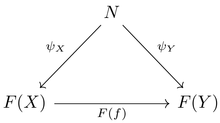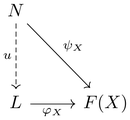범주론에서, 극한은 (category의 object들의) 곱, 당김(pullback), 역극한(inverse limit) 등의 공통적인 보편 성질(universal property)을 말하기 위해 만들어진 개념이다. 범주론적 극한은 위상적인 극한을 포함한다. 즉, 위상적인 극한은 범주론적 극한의 특수한 경우이다.
정의[편집 | 원본 편집]
극한의 정의는 universal cone, 즉 보편 성질을 만족하는 뿔이다. [math]\displaystyle{ J }[/math]-형의 [math]\displaystyle{ \mathcal C }[/math]의 다이어그램(공변 함자) [math]\displaystyle{ F: \; J \to \mathcal C }[/math]의 뿔 [math]\displaystyle{ (N, \psi) }[/math]이란 [math]\displaystyle{ J }[/math]의 임의의 대상 [math]\displaystyle{ X, Y }[/math]에 대하여 다음이 가환이게 하는 [math]\displaystyle{ \mathcal C }[/math]의 대상 [math]\displaystyle{ N }[/math]과 함수족 [math]\displaystyle{ \psi_\bullet }[/math]의 쌍이다. 즉, 그려지는 모든 삼각형이 가환이게 하는 쌍이다:
그러한 뿔 중, 다음과 같은 보편 성질을 가지는 [math]\displaystyle{ (L, \varphi) }[/math]를 다이어그램 [math]\displaystyle{ F }[/math]의 극한이라고 한다:
- 주어진 다이어그램의 임의의 뿔 [math]\displaystyle{ (N, \psi) }[/math]에 대하여,
- [math]\displaystyle{ N, L, F(X) }[/math] (F(X)는 주어진 다이어그램의 object)
- 로 이루어진 아래 다이어그램을 가환하게 하는 사상 [math]\displaystyle{ u: \; N \to L }[/math](factorization)이 유일하게 존재한다.
즉, 다음을 가환하게 하는 [math]\displaystyle{ (L, \varphi) }[/math]이다. (이는 [math]\displaystyle{ (L, \varphi) }[/math]과 [math]\displaystyle{ (N, \psi) }[/math]이 cone임에서 나온다.)
기존의 극한 개념으로 봤을 때 참으로 뜬금없는 정의인데, 왜 이름은 극한인 것인가? 그리고 이 개념을 정의한 이유는 무엇인가? 이는 많은 수의 범주론적 개념이 극한으로 일반화되기 때문이며, 범주론에서 가장 중요한 성질인 보편 성질을 capture하기 때문이다. 그리고 신기하게도, 이는 위상수학적 극한을 일반화한다.
자연 동형을 이용한 정의[편집 | 원본 편집]
이를 자연 동형(natural isomorphism)의 언어로 나타낼 수도 있다. 먼저, 뿔이란 꼭짓점에서 다이어그램으로 가는 자연 변환이라고 볼 수 있다. [math]\displaystyle{ J }[/math]-형의 [math]\displaystyle{ \mathcal C }[/math]의 다이어그램 [math]\displaystyle{ F : \; J \to \mathcal C }[/math]에 대하여, 꼭짓점 [math]\displaystyle{ V }[/math]에서 내린 뿔은 자연 변환 [math]\displaystyle{ \psi: \; \Delta_ V \to F }[/math]이다. 이때, [math]\displaystyle{ \Delta_V }[/math]는 [math]\displaystyle{ J }[/math]-형의 terminal category [math]\displaystyle{ V }[/math]⟲[math]\displaystyle{ 1_V }[/math]의 다이어그램이다.
이제 위의 자연 동형의 언어로 쓰여진 뿔을 이용하여 극한 역시 자연 동형으로 기술할 수 있다. 즉 다이어그램 [math]\displaystyle{ F }[/math]의 극한은 보편 성질을 만족하는 자연 변환 [math]\displaystyle{ \varphi: \; \Delta_L \to F }[/math]을 말한다.
예시[편집 | 원본 편집]
- 끝 대상: [math]\displaystyle{ J = \mathbf 0 }[/math]가 empty category일 때, [math]\displaystyle{ \mathbf 0 }[/math]-형의 [math]\displaystyle{ \mathcal C }[/math]의 다이어그램은 자명하게 유일하며 이의 극한은 다름 아닌 [math]\displaystyle{ \mathcal C }[/math]의 terminal object [math]\displaystyle{ 1 }[/math]이다.
- 곱: [math]\displaystyle{ J }[/math]가 discrete category일 때, 다이어그램 [math]\displaystyle{ F: \; J \to \mathcal C }[/math]는 [math]\displaystyle{ \{X_\alpha \in \operatorname{ob} \mathcal C: \; \alpha \in J \} }[/math]와 같은 의미를 가지게 된다. 이때, 극한의 함수족 [math]\displaystyle{ \varphi_\bullet }[/math]이 projection mapping의 역할을 하게 되어 주어진 다이어그램의 극한은 범주론적 곱이 된다.
- 멱범주: [math]\displaystyle{ F }[/math]가 같은 것 [math]\displaystyle{ X }[/math]만 가리키는 함자이면, 즉 상수 다이어그램이면, 그 극한은 같은 대상을 여러 번 곱하는 것이므로 멱범주 [math]\displaystyle{ X^J }[/math]가 된다.
- 이퀄라이저 (커널): 만약 [math]\displaystyle{ J= \{ \bullet\rightrightarrows \bullet \} }[/math]이면 다이어그램은 평행한(domain과 codomain이 같은) 두 morphism의 쌍을 나타낸다. 이때 그 극한은 두 morphism의 equalizer가 된다.
- 당김: [math]\displaystyle{ J= \{ \bullet\rightarrow \bullet \leftarrow \bullet \} }[/math]이고 [math]\displaystyle{ F }[/math]가 왼쪽의 [math]\displaystyle{ \bullet }[/math]들을 [math]\displaystyle{ X, Z, Y \in \operatorname{ob}\mathcal C }[/math]의 순서로 지정하는 다이어그램이라고 하자. 이때 [math]\displaystyle{ F }[/math]의 극한은 당김(pullback, fibre product라고도 부름)이 된다.
- 역극한: [math]\displaystyle{ J }[/math]를 반순서집합이라고 하고 이것을 범주로 간주하자. (반순서집합은 [math]\displaystyle{ x \le y }[/math]일 때 [math]\displaystyle{ x \to y }[/math]의 morphism을 만드는 방식으로 범주로 생각할 수 있다.) 이때 다이어그램 [math]\displaystyle{ F:\; J^{\mathrm{op}} \to \mathcal C }[/math]을 생각하면, ([math]\displaystyle{ J \to \mathcal C }[/math]의 반변 함자인 [math]\displaystyle{ F }[/math]에 대하여) [math]\displaystyle{ F }[/math]의 극한을 역극한이라고 한다.
- [math]\displaystyle{ J = \mathbf 1 = \{ \bullet }[/math]⟲[math]\displaystyle{ 1_\bullet \} }[/math]이면, 다이어그램은 단지 [math]\displaystyle{ \mathcal C }[/math]의 한 object [math]\displaystyle{ X }[/math]를 가리키는 함자가 된다. 따라서 vertex [math]\displaystyle{ N }[/math]의 뿔은 [math]\displaystyle{ N \to X=F(\bullet) }[/math]의 morphism과 같고, 이 morphism이 isomorphism일 때에만 주어진 뿔이 극한이 됨을 알 수 있다. 일반적으로 [math]\displaystyle{ J }[/math]가 initial object[math]\displaystyle{ 0 }[/math]을 가지는 범주이면, 임의의 다이어그램 [math]\displaystyle{ F }[/math]는 '[math]\displaystyle{ F(0) }[/math]과 isomorphic한 대상'이라는 극한을 가진다.
성질[편집 | 원본 편집]
해석학과 위상수학의 극한과의 관계[편집 | 원본 편집]
위상공간 [math]\displaystyle{ (X,\mathcal T) }[/math]이 주어져 있다고 하자. [math]\displaystyle{ \mathcal F(X) }[/math]를 X의 필터들의 ⊆-반순서집합이라고 하고, 작은 범주로 간주하자.
[math]\displaystyle{ x\in X }[/math]와 [math]\displaystyle{ F\in\mathcal F(X) }[/math]가 주어져 있을 때 [math]\displaystyle{ \mathcal U_X(x) }[/math]를 [math]\displaystyle{ x }[/math]의 근방 필터(근방들을 모두 모아 놓은 필터)라고 하고, [math]\displaystyle{ \mathcal F_{x,F} (X) }[/math]를
- [math]\displaystyle{ \{G\in\mathcal F(X):\; F\cup\mathcal U_X(x)\subseteq G\} }[/math]
가 생성하는 [math]\displaystyle{ \mathcal F(X) }[/math]의 충만한 부분범주(포함 함자가 충만한 부분범주)라고 하자.
[math]\displaystyle{ E:\mathcal F_{x,F}\hookrightarrow\mathcal F(X) }[/math]는 자명한 충실한 다이어그램이고, [math]\displaystyle{ \Delta }[/math]는 대각 함자이며 [math]\displaystyle{ \lambda:\; \Delta(F)\Rightarrow E }[/math]는 [math]\displaystyle{ G\in\mathcal F_{x,F} }[/math]에 대하여 [math]\displaystyle{ \lambda(G):\; F\hookrightarrow G }[/math]가 포함 함자가 되게 하는 자연 변환이다.
그러면 [math]\displaystyle{ F }[/math]가 [math]\displaystyle{ (X, \mathcal T) }[/math]에서 [math]\displaystyle{ x }[/math]로 수렴(필터가 주어진 점의 근방 필터를 부분 집합으로 포함)하는 것과 자연 변환 [math]\displaystyle{ \lambda }[/math]가 다이어그램 [math]\displaystyle{ E }[/math]의 극한인 것이 동치이다. [1]


